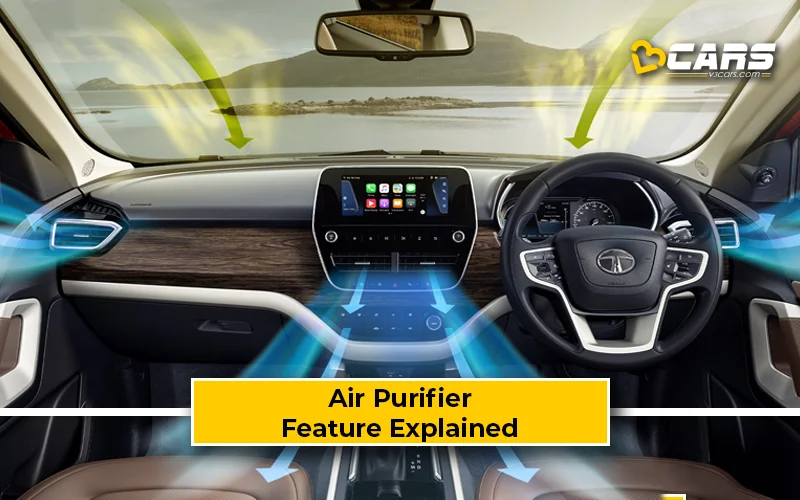Air Purifier – Feature Explained
With increasing levels of air pollution in many Indian cities, the air inside your car can sometimes be as polluted, or even more so, than the air outside. Dust, pollen, allergens, pollutants, and even unpleasant odours can enter the cabin, affecting the health and comfort of occupants. This is where an air purifier in cars becomes a highly valuable and increasingly popular feature, designed to ensure you breathe cleaner, healthier air on the go.

What Is An Air Purifier In A Car?
An air purifier in a car is a system integrated into the vehicle’s cabin or ventilation system (or sometimes a standalone unit) that actively filters and cleans the air inside the passenger compartment. Its primary goal is to remove harmful particles, allergens, odours, and sometimes even viruses and bacteria, providing a healthier and more pleasant environment for occupants.
How Does An Air Purifier Work?
Car air purifiers typically employ a combination of filtration technologies:
- Multi-Layer Filtration:
- Pre-filter: Catches larger particles like dust and hair.
- HEPA (High-Efficiency Particulate Air) Filter: This is a crucial component, capable of capturing very fine particles (as small as 0.3 microns) including PM2.5, pollen, dust mites, and pet dander.
- Activated Carbon Filter: Absorbs gases, volatile organic compounds (VOCs), and odours (like smoke, exhaust fumes, food smells).
- Ionizers (Optional): Some systems also include an ionizer. This component releases negatively charged ions into the air. These ions attach to positively charged particles (like dust, pollen, and some bacteria), making them heavier and causing them to fall out of the air or be more easily captured by the filter.
- UV-C Light (Rare/Advanced): Very advanced systems might incorporate UV-C light to neutralise airborne viruses and bacteria, though this is less common in standard car purifiers.
- Fan System: A small fan draws cabin air through these filters and then circulates the purified air back into the cabin.
- PM2.5 Display (Optional): Many modern in-car air purifiers come with a digital display that shows the real-time PM2.5 (Particulate Matter 2.5) levels inside the cabin, giving occupants a clear indication of air quality.
- Automatic Mode: Some purifiers can operate in an automatic mode, sensing the air quality and adjusting fan speed and filtration intensity accordingly.
What Are The Pros And Cons Of An Air Purifier In A Car?
Here are the pros, or advantages, of an air purifier in a car:
- Improved Air Quality: Significantly reduces the concentration of pollutants, dust, pollen, allergens, and harmful gases in the cabin.
- Health Benefits: Particularly beneficial for individuals with allergies, asthma, or respiratory sensitivities, providing a safer breathing environment.
- Odour Removal: Effectively eliminates unpleasant smells like smoke, pet odours, or lingering food smells, making the cabin fresher.
- Enhanced Comfort: Contributes to a more pleasant and comfortable driving experience for all occupants.
- PM2.5 Monitoring: Real-time display of PM2.5 levels raises awareness about air quality and the purifier’s effectiveness.
Here are the cons, or disadvantages, of an air purifier in a car:
- Filter Replacement Cost: Filters (especially HEPA and activated carbon) need regular replacement (typically every 6-12 months, depending on usage and air quality), adding to maintenance costs.
- Limited Effectiveness (Standalone Units): Smaller, standalone plug-in purifiers have limited effectiveness in purifying the entire cabin air compared to integrated systems.
- Noise: While generally quiet, some purifiers, especially at higher fan speeds, can produce a noticeable hum.
- Power Consumption: Integrated systems draw power from the car’s electrical system.
- Initial Cost: Adds to the vehicle’s price, typically found in mid-to-higher variants.
Can An Air Purifier Be Installed From The Aftermarket?
Yes, air purifiers can be easily installed from the aftermarket. They typically cost Rs. 3,000 or more, depending on the type. There are several types of aftermarket car air purifiers:
- Plug-in Units: These are compact devices that plug into the car’s 12V power outlet (cigarette lighter socket) or a USB port. They are portable and easy to use.
- Cup Holder Units: Designed to fit into a car’s cup holder, offering a neat and stable placement.
- Integrated/Under-Seat Units: Some more advanced aftermarket solutions can be discreetly placed under a seat or integrated into the ventilation system, often requiring professional installation.
Aftermarket purifiers vary widely in their effectiveness, filter quality, and features (like PM2.5 display). While convenient, they might not offer the same level of seamless integration or purification capacity as factory-fitted systems.
Affordable Cars In India That Offer An Air Purifier?
The air purifier feature has gained significant traction in the Indian market due to rising pollution concerns. It is now increasingly available in cars and SUVs from the B2-segment and above.
You can typically find this feature in:
- B2 Hatchbacks (top variants): Such as the Maruti Suzuki Baleno, Hyundai i20, Tata Altroz.
- B2 Sedans (top variants): Like the Hyundai Aura, Honda Amaze.
- B2 SUVs (mid to top variants): This is where it's most common, including models like the Maruti Suzuki Brezza, Hyundai Venue, Kia Sonet, Tata Nexon, Mahindra XUV 3XO, Nissan Magnite, Renault Kiger.
- C SUVs and Sedans: Almost universally available in their higher trims (Hyundai Creta, Kia Seltos, Maruti Suzuki Grand Vitara, Volkswagen Virtus, Skoda Slavia, Mahindra XUV700, Tata Safari, MG Hector).
Also Read: What Is 60-40 Split-Folding Rear Seat Backrest? Feature Explained
Helpful Tools:
- Fuel Cost Calculator for Cars – Know your monthly fuel expense based on usage and mileage
- Car On-Road Price Calculator – Convert ex-showroom to on-road price for any city
Sell Used Car Online – Enter your car and contact details to get an instant price estimate and book a free inspection with our partner network


0 Comments